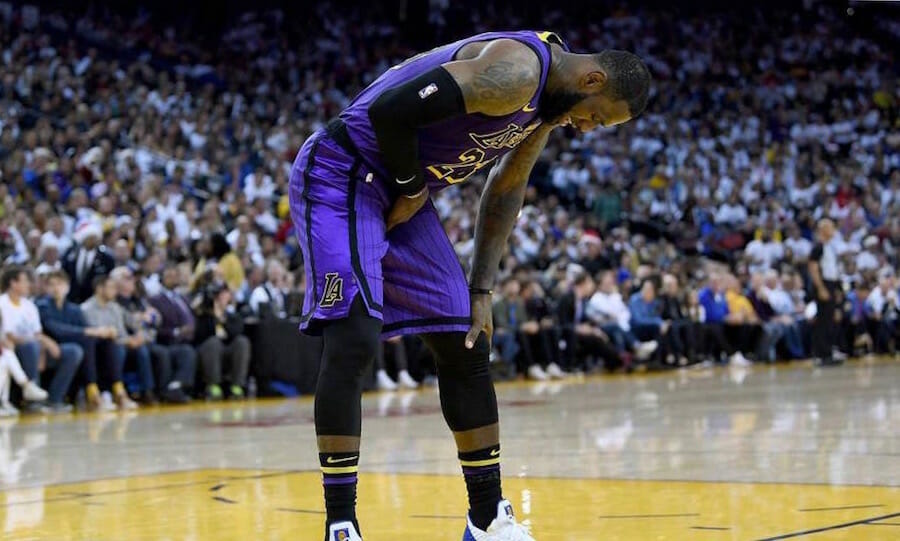
image: SportingNews.com
Anyone following sports news so far in 2019 knows about how the Los Angeles Lakers’ primary investment (read: LeBron James) has been sidelined with an injury through an important juncture of the season. LBJ has been out with a groin strain for over a month and although he attempted a brief return at the end of January his comeback was halted after pain persisted and plagued his play, once again relegating him to the bench prior to the NBA All-Star break. This delay is by no means uncharacteristic, as studies show that despite the identification of risk factors and strengthening intervention for athletes, groin strains continue to occur in sport and when not properly addressed can be debilitating, chronic, and potentially career ending.
Today, our clinic is here to provide succinct insight into groin strains so that you can better understand and treat this pain in the rear (err…opposite of that) ailment and get back out on the court, field, or arena.
What You Need to Know About Groin Injuries in Sports and How Physiotherapy Can Help
What is a Groin Injury?
A groin injury is more technically known as an adductor muscle strain, which is an acute injury to the groin muscles on the inside of the thigh. Although many different muscles can be injured, the most common are the Adductor Longus, Medius and Magnus, and the Gracilis.
Symptoms of adductor strain may include dull and/or sharp pain the region (including when you lift your knee) in addition to bruising and swelling of the inner thigh, atypical warmth in the groin and/or inner thigh, weakness or tenderness in the area, and limping along with difficulty in functional movement. Walking much less running can become a tremendous is not impossible chore.
Like with most other injuries, a groin strain can be categorized as a Grade 1 to 3 injury with the stretch or muscle tear ranging from minor to more extreme, with severity of symptoms corresponding to the grade. Your first point of contact (physician or physiotherapist) will ask about whether you heard a popping sound when the event occurred, and/or if swelling and pain followed. When LeBron James’ injury happened there was no doubt about the significance as he grimaced and limped off the court.
Which Athletes Are Most Susceptible?
Data finds that ice hockey and soccer players are especially susceptible to adductor muscle strains, given the nature of the body movements applied to perform each. An estimated 10-11% of all ice hockey and soccer player injuries are groin strains. With these two sports being particularly popular in Greater Vancouver you can see why our clinic commonly sees athlete patients for this ailment. However, as this article’s all-star reference shows, no sport where running, jumping, kicking, or pivoting is done is isolated from this risk. Groin injuries are common in basketball, football, snowboarding, surfing, tennis, and even jogging/running. Knowing this will help you devise a prevention plan, which will be addressed below.
Risk Factors and Causes in Sports
Studies show that the most common risk factors for adductor muscle sprains include stiffness, previous history, an imbalance of hip adductors-to abductors strength, and a diminished ROM for hip abduction. The same studies find that while groin strain can come from quick changes in acceleration, speed, and direction, overuse injuries are considered to be the primary cause.
Treatment and Prevention
Training each of the 3 adductor muscles to improve both flexibility, range-of-motion (ROM), and strength is essential to treating and preventing groin strain. In addition, attention should be paid to the hips and lower extremities for additional support. A physiotherapist will walk you through a variety of exercises, including floor stretches, chair lifts, side lifts, and knee squeezes and bends. The following physical therapy treatments and therapies can be applied to address adductor muscle injury:
- Massage therapy
- Laser therapy to the pectineus and adductor complex to reduce inflammation and pain
- Acupuncture and dry needling
- K-taping (for when you’re back in training/playing)
Experts also find that groin injuries in professional sports typically occur in pre-season training, which indicates that extended periods of adductor complex inactivity are to blame. After months of less activity, the adductor muscles are not tasked as much as they should be, with flexibility, strength, and ROM falling to the wayside. Therefore it is imperative that athletes maintain their physiotherapist prescribed exercise regime throughout the entire year.
An improved Gait can also help make a difference, and so custom orthotics for both walking and playing footwear can become a part of your groin injury prevention plan. In addition, a physiotherapist can help identify biomechanical disorders of the lower limb (i.e. excessive pronation, leg length differences, etc.) that may contribute to groin strain risk and can provide corrective therapies.
Lastly, remember to warm up and cool down properly before game/activity time.
If you are experiencing pain, discomfort, and/or limited range of motion around the inner thigh adductors and you reside in the Greater Vancouver area we encourage you to contact Absolute PhysioCare right away.
